If you are searching for a scenic location rich in history and art, where your budget will stretch to a property larger than a bedsit in Florence, then Umbria is just the place.
Just like neighbouring Tuscany you will find rolling hills, vineyards, olive groves, woods, lakes, rivers and mountains. There are country lanes bordered with cypress trees, and charming hill top villages to explore. No wonder, the Umbria tourism website , refers to it as the “Green heart of Italy” (Cuone verde d’italia)
Location
Located in the centre of Italy, bordering Tuscany, Lazio and Le Marche, Umbria is the only region with no coastline. The town of Orvieto is in fact about two hours drive from the sea. The capital city of the region, Perugia, is only 1 hour 20 minutes from Siena. The drive from Orvieto or Terni to Rome can be done in less than an hour and a half.
If you need a little help finding and buying your home in Umbria, our trio of property experts, the Golden Three will make it all very easy. Just fill in the form and we’ll be in touch.
The region consists of only two provinces, Perugia and Terni. Geographical areas of note in Umbria include the Valley of Umbria and the Tiber Valley (Valle del Tevere). Due to their proximity to an airport, the areas around Perugia and Lake Trasimeno are popular places to start a property search.
Property in Umbria
There are many charming styles of property available, from town houses and apartments in the attractive town centres, to farm houses and villas in the surrounding countryside. In Umbria prices get lower in the southern areas of Terni, Narni, Amelia, Spoleto and Norcia and there are a number of properties needing renovation.
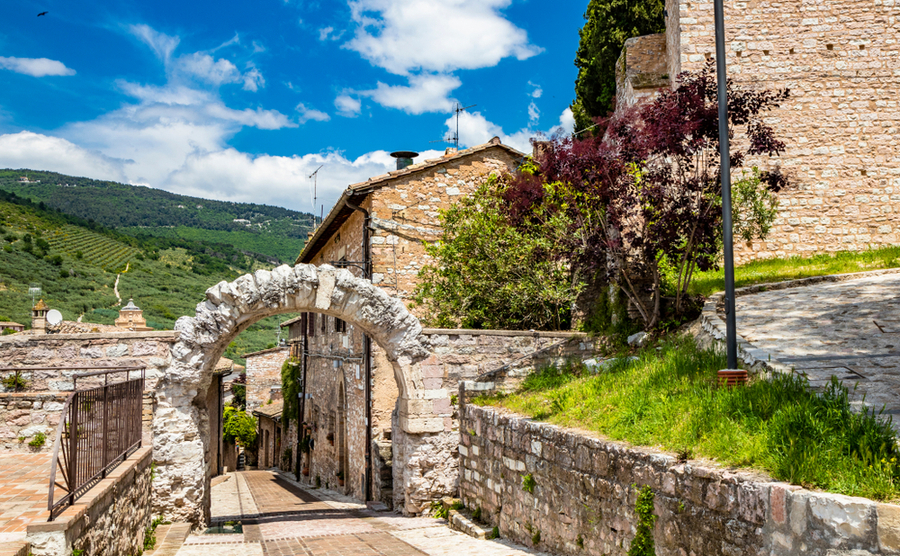
Your new neighbourhood? A village street in Spello
Property prices in Umbria
In the more remote villages you can still find houses costing less than €100,000, and they tend to be built of stone or red brick with loads of character and spectacular views. It’s even possible to find a small renovation project for less than €50,000.
On average, property prices in Umbria are less than half the price per square metre of those in neighbouring Tuscany.
On average, property prices in Umbria are less than half the price per square metre of those in neighbouring Tuscany. In September 2021, the Perugia province of Umbria registered a slight drop in prices to €1,041/m2. Whereas, Terni province has actually begun to rise and is levelling out at around €1,025/m2.
In comparison, the average price per metre square in Tuscany is €2,234. However, popular Tuscan cities such as Florence and Siena do contribute to this high average. Just across the border from Umbria in Tuscany’s Arezzo province the average price is only €1,373/m2.
Start your property search in Umbria.
Take a look at these highlights of Umbria.
Perugia
Perugia was founded by the Etruscans, around the 7th century BC on top of a steep hill. It was a prosperous roman municipality, and during the medieval period it was one of the most powerful cities in central Italy. It is now the capital city of Umbria and the largest.
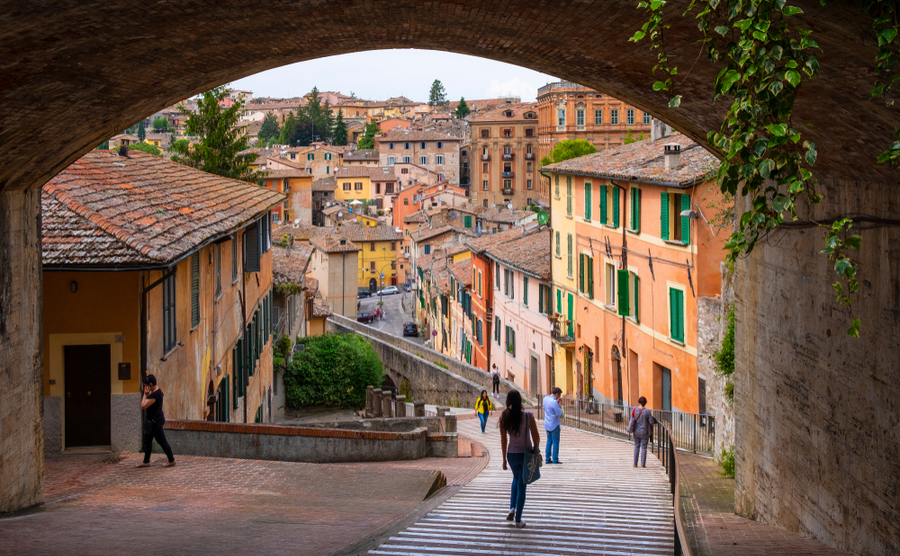
Perugia (ArtMediaFactory / Shutterstock.com)
Today the city successfully combines history and tradition with modern life and events. Such as the delicious Eurochocolate Festival. Museums, craft workshops, traditional cuisine and amazing views enchant visitors. While the University students enjoy the vibrant nightlife, lovers of jazz can experience one of Europe’s top Jazz Festivals.
Even if you choose to live in a village, it is good to have a big city like Perugia nearby for shopping and days out. At the heart of the historic centre is Piazza IV Novembre with a cathedral and the unusual Maggiore fountain, with its statues and bas-reliefs in pink and white marble.
For country properties in particular, ensure you use a trusted, specialist Italian property lawyer. We can put you in touch.
Highlights of a trip into Perugia could also include the Gothic palace of Palazzo dei Priori, which houses Umbria’s National art gallery and historic rooms. Then there is the underground section of the old fortress, Rocca Paolina and the Etruscan city gates and walls.
Lake Trasimeno
Lake Trasimeno is central Italy’s largest lake, with a surface area of 128 km². This shallow lake is the ideal place to explore by kayak or take sailing lessons. You can also try windsurfing, kitesurfing, wakeboarding and water skiing. To feel the fresh air and freedom of being on the lake try renting a motorboat or bikes to explore the lake and its shoreline. Or you could walk a 70km loop of the lake to fully take in the views and lakeside villages.
Ed Sheeran owns a farmhouse with vineyard in the Paciano hills
Castiglione del Lago is located on a limestone promontory. From here you can see a castle, as well as the medieval walls of Palazzo Ducale. A path leads to Rocca del Leone fortress, a superb example of Umbrian military architecture.
Other villages around the lake include Panicale and Citta della Pieve, with its narrow alleyways. From the medieval village of Passignano you can take a boat out to the island of Maggiore. However, the largest island on the lake is Polvese, which is a tranquil public park with a monastery, church and castle.
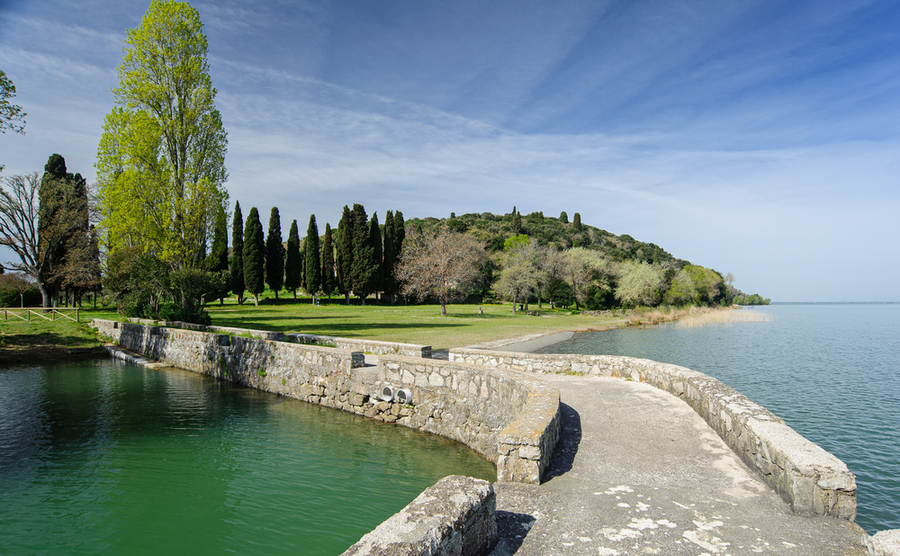
An ancient dock on Polvese island, Trasimeno.
Local events are fun too. In September the largest frying pan in the world is used at the local fish festival. They cook up to an amazing two tons of fish an hour. The lake itself is not the only highlight either. Gentle hills form the backdrop of Lake Trasimeno, along with woodland, vineyards, olive groves and fields of sunflowers and corn. A perfect place for a quiet retreat from a busy life.
If you want a personal recommendation on the joys of the area, singer, songwriter Ed Sheeran owns a farmhouse with vineyard in the Paciano hills. According to rumours around the lake he may be purchasing two more properties, one of which could house a recording studio. He spends a lot of time in Umbria and during lockdown he started learning Italian.
Religious Heritage
Many famous saints come from Umbria including St. Francesco of Assisi, St. Valentine of Terni, St. Chiara and St. Benedetto of Norcia. There are many pilgrim’s ways, that can be followed on foot, by bicycle or on horseback. The religious heritage and cultural events create a warm and welcoming community atmosphere.
Asissi
Between art and spirituality, a visit to the Medieval town of Assisi is essential. Recognised as a UNESCO World Heritage Site, Assisi is also a very welcoming place, where its inhabitants love to share the old traditions with visitors. For example, Calendimaggio, is a splendid historical event that turns Assisi into an old Medieval town inhabited by knights and ladies, bowmen and flag-bearers.
Food festivals
Umbria’s economy is mainly based on agriculture, tourism and industry. The produce grown locally can be tasted at the popular village festivals, called “Sagre”. Each festival is dedicated to a specific food that is in season locally. In Umbria this could be chestnuts, mushrooms, truffles, fava beans, snails, wild boar, lamb or grapes. At these events you may also see traditional music, dance and crafts.
Taste of Umbria
You can live a healthy lifestyle in Umbria by enjoying good home cooking, using locally grown produce, such as grains, vegetables, herbs, honey and olive oil. Green grocers and town markets sell an abundance of local fruit and vegetables.
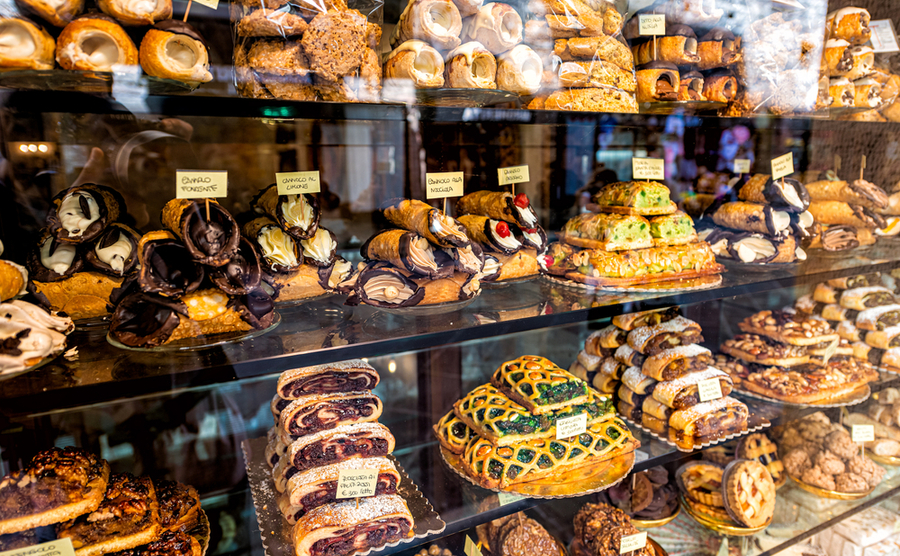
A cake shop in Assisi, Umbria
A fine bottle of Umbrian wine shared with friends is often accompanied by cheese and cold cuts of meat. This might include pecorino and caciotta cheese and slices of prosciutto di Norcia and Dried sausage (salsiccia Secca). The famous Umbrian truffles are often used to flavour cheeses, salami, scrambled eggs, dumplings, pasta sauces or sprinkled over grilled meats.
Umbria’s vineyards
Most of the vineyards are planted on terraces etched into the lush Umbrian hills. A combination of winter rain and warm summers give the area an ideal climate for growing grapevines. The Orvieto area is home to some of the best white wines from Umbria, while Torgiano and Montefalco produce the region’s finest red varieties.
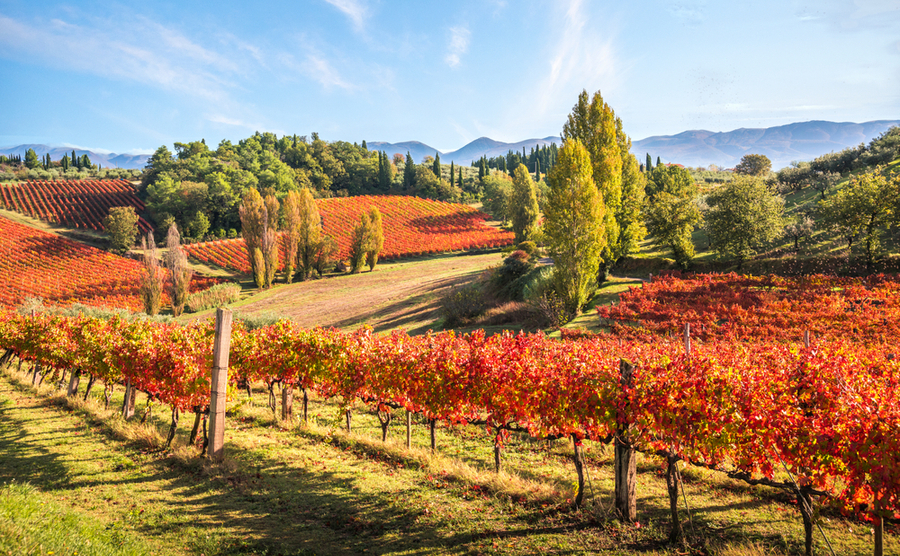
The vineyards of Montefalco
Umbrian soil is excellent for vineyards; a mix of sand, clay, ancient marl, and volcanic soils soak up water during the rainiest winter months and store it underground. In the summer, when the weather is usually extremely dry, the vines still have access to some of this underground water.
Towns in Umbria
Over the years, Tuscany’s most beautiful towns have become famous, and in some cases rather touristy. However, many beautiful towns in Umbria remain authentically Italian, have interesting features and yet aren’t packed full of tourists.
Discover Spoleto’s medieval arched bridge, Todi’s cathedral, Montefalco’s panoramic views, Norcia’s heritage of art, Narni’s roman history, Amelia’s ancient polygonal walls, and Bevagna’s port that dates back to the Augustan age.
The towns of Umbria are historical treasures, with architecture and cultural events that charm many visitors. Perugia, Assisi, Gubbio, Orvieto, Todi, Spello, Foligno, Città di Castello and Terni are all top of the list of must-see towns.
Villages in Umbria
There are so many quaint villages that you can discover, simply by driving around the countryside. Many of these hill top villages are listed as among the most beautiful in Italy. Lovely places to enjoy a laid-back village life and marvel at the magnificent views, over your morning coffee.
Beautiful Umbrian villages
You may have seen the word “village” translated to “Borgho” in Italian. However, a borgho isn’t simply a village. Generally they are fortified and can date from the Middle Ages to the Renaissance. Lots of information can be found about 28 of the most beautiful borghi in Umbria on the “borghi più belli d’Italia” website
A typical Borgho
Monteleone d’Orvieto is located in the extreme north of the province of Terni, along the border that separates Umbria from Tuscany. This picturesque village is immersed in the rolling hills of Umbria, surrounded by vineyards, olive groves, woods and streams. A 200-degree view can be seen from the terrace at the end of the village. The village is recognised for its walls of handmade red brick and the Teatro dei Rustici. For a population of less than 1,500, there are food shops, a pharmacy, a restaurant and post office.
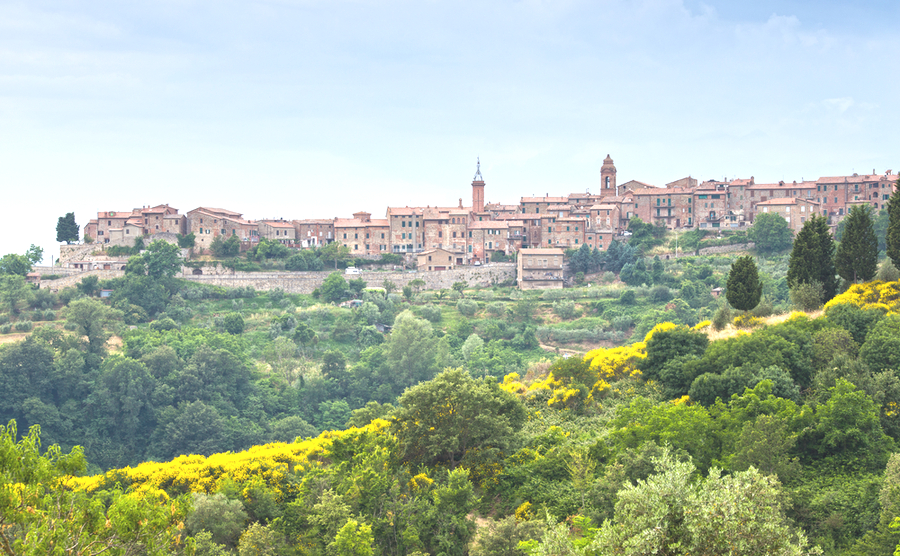
Monteleone d’Orvieto, Umbria
Apartments occasionally come up for sale for as little as €30,000. If you are looking for a home with an additional building suitable for holiday rental, there are currently two villas for sale near Monteleone d’Orvieto, for the amazing price of just €350,000.
Arts and Crafts in Umbria
Traditional arts and crafts are still going strong in Umbria, so you are sure to find some lovely pieces to decorate your Umbrian home. Particularly look out for ceramics, paintings, basketwork and embroidery. You will also find furniture using wood, artistic glass and wrought iron.
One of the cities in which wood carving is most famous is Città di Castello. In the towns of Perugia, Terni, Spoleto and Torgiano you will even find craftspeople working with Gold as they have done in Umbria since the Etruscans times.
20 kilometres south of Perugia in Deruta, three hundred ceramics producers, create ceramics that are exported worldwide. Shops selling their brightly painted pottery also fill the small town streets. To see some beautiful old pieces, visit the Museo delle Maioliche.
The Moretti Caselli studio has been creating and restoring stained-glass windows and other glass art since 1860, and you can learn about the entire process on a guided visit with one of the artists.
Getting to Umbria
Umbria has a regional airport, the Aeroporto Perugia, “San Francesco d’Assisi”, located midway between Perugia and Assisi. There are currently flights from London, Catania, Malta, Brussels and Tirana. If you are flying into Milan, you can get an internal flight down to Perugia from Milan Linate airport. Ryanair flights from London Stansted to Perugia are selling for as little as £31 return in November 2021.
The north of the region can also be reached via Florence airport which has good rail and road links into Umbria.
Some towns like Orvieto are on the Florence to Rome railway line making Rome airport another option for residents in the south west of Umbria. It takes a little over an hour from Rome’s train station to Orvieta, and can cost as little as €8.60. Some towns can also be reached by the Florence to Ancona rail line or small scenic branch lines.
Earthquakes
There is a chance of feeling an earthquake in Umbria. The highest risk area is the mountain range in the south eastern quarter of the region. The chance of seismic activity gets lower on the western half of Umbria and particularly around Amelia, Orvieto and Narni.
If are planning a major renovation, it is obligatory to incorporate seismic reinforcements to buildings. Old houses that were built before stricter building regulations came into effect, should have a “seismic vulnerability analysis” carried out to assess what can be done to improve the seismic resistance of the building. This might include tie-rods and other supports. Ask your geometra what bonus schemes are available from the government, it could cost you nothing.











